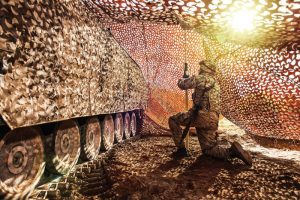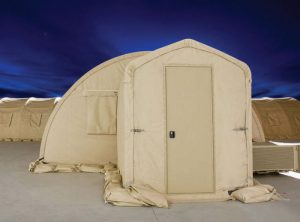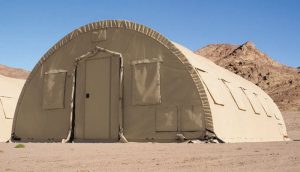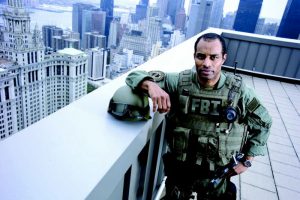
Part II of a two-part feature on the outlook for the technical textiles market.
By Steve Warner, Contributing Editor
In the last issue of Textile World, Part 1 of “2018 State Of The U.S. Technical Textiles Industry,” looked at economic and trade factors impacting the sector. Part 2 focuses on specific segments of the industry including automotive, military and law enforcement applications for technical textiles.
Automotive/Light Vehicle Market
The largest user of technical textiles is the vehicle manufacturing industry. After a decade of steady, impressive growth, North America experienced a small contraction in the number of passenger vehicles made in 2017. About 17.25 million cars and light trucks were sold, a decline of 1.8 percent from 2016. The United States made 11.56 million or 67 percent of these vehicles. Canada produced 2.3 million, and Mexico accounted for another 3.4 million.
The average amount of material going into a vehicle is 28 square yards (yd2), which means about 323.7 million yd2 went into domestic-made vehicles in 2017.
There are five primary applications for textiles in vehicles — passenger restraint systems such as airbags and seatbelts, headliners and seating, trunk liners, flooring, and tires — plus smaller applications like hoses and acoustic/vibration insulation. The major interior vehicle applications are in seating and flooring.
The domestic vehicle production base has been moving from Detroit over the past decade, in part because Asian and European automakers have developed manufacturing operations in the southern United States. The automotive industry tends to operate with a cluster supplier base — meaning prime parts suppliers are located nearby. The recent announcement of a new $1.6 billion Toyota/Mazda manufacturing plant in Alabama, plus expansions of the Volvo plant in South Carolina and the Daimler plant in Alabama, spells good news for the domestic automotive textile industry. Further, Stamford, Conn.-based Hexcel Corp., Tokyo-based Toray Industries Inc. and Tokyo-based Teijin Ltd. recently have announced more than $2 billion in carbon-fiber related production expansions in the United States, targeted mostly for the automotive industry.
If there is a possible breakout new market segment for smart textiles, it is in vehicles. Heating and cooling seat technology already is in use. Now, assembly manufacturers are exploring seating material that can detect an occupant’s size and weight to provide a more comfortable ride and prevent driver fatigue. Potential applications may soon also include interior materials that change color, allowing driver customization.
Airbags
The airbag sector unfortunately is best known right now for recalls. However, recalls aside, the sector has experienced phenomenal growth over the past 20 years, which is expected to continue. Its fate, too, is not necessarily tied to the number of vehicles manufactured. There is an increasing number of airbags placed in each vehicle; and developing nations with a growing appetite for vehicles, including India and Brazil, are demanding mandatory airbag safety requirements.
The development of driverless cars will present unique new opportunities too, because present designs are intended only for forward-facing occupants.
Thus, airbags are estimated to be the fastest growing market segment in automotive textiles at 8.1 percent. The most common fabric used is nylon 6,6. Because of the heat generated by a quickly inflated bag, silicone-coated fabrics are used for airbags that encounter a vehicle occupant’s face.
The three major U.S. airbag manufacturers are:
- ZF TRW Automotive Holdings Corp.;
- Autoliv Inc.; and
- Joyson Safety Systems (JSS).
Industry consolidation continued for the airbag industry in 2017. JSS purchased the assets of bankrupt Takata Corp. for $1.6 billion, instantly vaulting the U.S.-headquartered company into the number two spot on the global list of airbag suppliers behind Autoliv.
While the number of airbag suppliers is shrinking, plant capacity and global locations of the remaining manufacturers increases. Toray Advanced Textile recently announced its first foray into North America, building a new plant in Mexico to make nylon fiber and fabric for airbags to supply the growing U.S. and Mexican automotive manufacturing industry.

Military/Law Enforcement
For military applications, there are three critical criteria — concealment, mobility and operating in extreme weather conditions.
The key point to be made about the military’s technical textile needs is that sequestering all aspects of the military’s competitive warfighting edge have eroded, and that money now will be spent to fix shortcomings. After more than a decade of fighting in Iraq and Afghanistan, the U.S. military now is switching back to building a force that can deter both established — Russia — and emerging military powers — China.
The Budget Control Act (BCA) of 2011 dramatically reduced funding for the Department of Defense (DoD) for the last 6 years. The BCA contains a threat that binds the spending limits/caps and, if spending exceeds budget, sequestration takes place with the draconian result of automatic cuts across the DoD budget.
However, things are about to change. The Trump administration and Congress has dramatically increased military spending in the fiscal year 19 and fiscal year 20 budgets, jumping from $594.9 billion actual in fiscal year 17 to $686 billion in the new fiscal year 19 budget. Further, in his State of the Union address this year, President Trump called on Congress to end sequestering. The passage of much higher military budgets for fiscal year 19 and fiscal year 20 has circumvented sequestering restrictions but it is still law for fiscal year 20 and fiscal year 21.
Although sequestration’s threatened cuts have been somewhat mitigated by Overseas Contingency Operations funding and short-term budget agreements such as in 2013 and 2015, appropriations have been unpredictable and inconsistent. The five-year decline of military contracts because of BCA has resulted in about a 50-percent drop in the industry for needs such as shelters, ballistic vests, ammunition pouches and other products made from technical textiles. With only sporadic contracts, it has been difficult for military contractors to maintain a trained and ready workforce. The military branches have, in turn, been forced to stretch out the shelf life of products which are increasingly needed to be replaced, resulting in what the DoD has called strategic atrophy.
It is too soon to tell though how much this new higher budget will impact the industry for specific products such as shelters and personal equipment. Most of the increases will go to big ticket items like planes, missile defense systems and ships. The technical textiles industry, however, should see a significant bump through the peripheral support items such as aircraft shelters. Plus, the budget calls for an increase in the troop level by 25,000 which should increase the need for more personal protection equipment and shelters, among other items.
Brought on by the conflict in Ukraine and possibly in Korea, one common theme you will find in looking at pending procurement is the emphasis on equipment for extreme wintry conditions. The Marine Corps has created a new small expeditionary Rotational Force-Europe, which is testing equipment in Norway. A couple of the problems that have been revealed include operating touch screens with gloves, and the performance of zippers and hook-and-loop closures under harsh temperatures.

Berry Amendment Protection
One of the most irritating issues revolving around the law to protect domestic sourcing is the ignorance of military procurement officers of the Berry Amendment’s requirements. In July 2017, the DoD’s inspector issued its Defense Logistics Agency Compliance with the Berry Amendment and the Buy American Act report. The Defense Logistics Agency (DLA) oversees procurement, including more than 8,000 textile items, most of them covered by the Berry Amendment. In a sample audit, the Government Accountability Office (GAO) found that DLA contracting personnel complied with the Berry Amendment for only 13 of the 32 contracts reviewed. The remaining 19 contracts were not in compliance, and were valued at $453.2 million. Further, 12 of 56 contracts reviewed did not comply with the Buy American Act.
Shelters
The key trends in military shelters are mobility and operating in harsh climates. The Army is rethinking its command post applications, and this may have a serious impact on the shelter industry. Under a directive called Command Post Integrated Infrastructure (CPI2), the Army is looking at the next generation of command post shelters to support a more agile, expeditionary force. Speed and mobility have become more critical components. The thinking is a command post must be able to transport and be operationally ready within 30 minutes. What this means, is more of the hard-shell structures for housing that emerged in 2016 at the expense of fabric shelters. Hard-shell structures may be put on wheels to become mobile, and come ready-to-go with wiring, air conditioning and communications. The move towards hard-shell styles may have impact on the currently accepted Deployable Rapid-Assembly Shelter (DRASH). These fabric structure modules may lose out as the hard-shell modules can offer more quick-start amenities.
On the positive side, shelter manufacturers are reporting more orders for accommodating 600-, 150- and 25-man camps. There also is an expressed demand for cold-weather shelters and clothing, which is probably driven by the conflict in Ukraine.
The following list contains most of the military shelter manufacturers:
- Outdoor Venture Corp., Stearns, Ky.;
- Camel Manufacturing Co., La Follette, Tenn.;
- Hunter Defense Technology (HDT), Solon, Ohio;
- Alaska Structures, Anchorage, Alaska;
- Diamond Brand Canvas Products, Asheville, N.C.;
- Johnson Outdoors Gear Inc. (Eureka), Binghamton, N.Y.;
- CAMSS Shelters, Kirkland, Wash.;
- Anchor Industries Inc., Evansville, Ind.;
- Cilena Tent, Celina, Ohio;
- Western Shelter, Eugene, Ore.; and
- UTS Systems, Fort Walton Beach, Fla.

Ballistic Vests/Personal Protection Equipment
The military continually is working to develop the next-generation soldier protection systems, seeking a balance of protection and comfort to protect the warfighter from chemical, biological, environmental and impact issues.
For individual ballistic protection, the first factor is always improving projectile impact kinetic energy disbursement. After protection, there is a weight race. How can the load be lightened? Other factors are the fit of the system as well as self-reporting features such as health sensors and self-healing abilities.
The Soldier Protection System (SPS) is a suite of personal protection subsystems intended to provide equal or increased levels of protection against small-arms or fragmenting threats. The major component subsystem for the industry is the soft armor Torso and Extremity Protection (TEP). TEP is divided into 4 main tiers of protection:
- Tier 1: Concealable;
- Tier 2: Low Visibility;
- Tier 3: Tactical; and
- Tier 4: Full Spectrum.
Some of the major ballistic vest military contractors include KDH Defense Systems Inc., Eden, N.C.; Point Blank Enterprises Inc. and Protective Products Enterprises, Pompano Beach, Fla.; Hawk Protection Inc., Pembroke Pines, Fla.; Shortbark Industries Inc., Vonore, Tenn.; and Carter Enterprises LLC dba Mil-Spec Enterprises, Brooklyn, N.Y.
Gradually, the weight for the Outer Tactical Vest (OTV) has been reduced. In 2008, a typical OTV weighed about 33 pounds. A Generation II OTV ballistic protection system is now down to less than 30 pounds. The new vital torso protection system (VTPS) is scalable and can now shed up to an additional 14 percent of the weight through change-out modular components depending upon the tactical situation. But the Army isn’t satisfied — new directives call for increased weight reduction with the goal of losing another 20 percent.
The U.S. Army Research Laboratory (ARL) is exploring bioenabled and protective materials that combine protection against multiple environmental, detection and ballistic threats. It also is looking at signature management technologies to decrease the probability of a soldier being seen or heard by dampening the soldier’s thermal, electromagnetic or visual characteristics signature. Finally, ARL is looking at improved body armor ballistics and blast threats.
The new soft armor vest and tactical vests entered full-rate production in fiscal year 2017. The sensor systems — which include an integrated sensor system that can measure heart rate, temperature and hydration levels — are still in the development phase. New protective coverage for the pelvic, groin, side and neck are being introduced.
Soft body armor is made using either woven aramid fibers or nonwoven ultra-high-molecular-weight-polyethylene.
In addition to the military, mass shootings and attacks on law enforcement officials have created a high civilian and law enforcement demand for body armor. In 2016, the global market was estimated to be about $4 billion with a U.S. share of $465 million. In the United States, the growth is not only for law enforcement officials, but also for other types of first responders such as emergency medical technicians and firefighters.
While the military regulates standards for body armor, the only nationally accepted standard for body armor worn by law enforcement and corrections officials is the standard issued by the National Institute of Justice (NIJ), an agency of the U.S. Department of Justice. NIJ has developed different classifications for body armor as follows:
- Type I — Designed to protect against lower velocity rounds. This is the lightest and most comfortable vest to wear.
- Type II-A — Protects against slightly higher velocity and is considered the bare minimum requirement for law enforcement vests.
- Type II — Armor is protection is heavier.
- Type III-A — Used for protection of high velocity handguns, considered the highest protection available for most handguns. Weight and bulk eliminates concealment of the vest.
- Type III — Used in tactical situations for protection against rifles.
- Type IV — Protection against armor piercing rifles and often uses ceramic plate inserts.
Helping drive market growth, is the Bulletproof Vest Partnership (BVP) program, a U.S. Department of Justice initiative designed to provide state and local jurisdictions with financial help in purchasing bullet-resistant body armor. Under the program, local governments are reimbursed up to 50 percent of the cost of each unit. Priority for the grants are given to jurisdictions under 100,000 in population. Since 1999, BVP has award more than 13,000 jurisdictions a total of $430 million in federal funds for the purchase of 1.3 million vests as of July 2017.
The increased interest in civilian purchases has created a crowded manufacturing industry with now more than 50 companies listed by the Justice Department as meeting its standards requirements. As expected in an emerging market, there seems to be the beginnings of industry consolidation through mergers and acquisitions. In 2017, Safariland Group, Jacksonville, Fla., made a series of acquisitions of smaller manufacturers; and already in 2018, a merger between KDH Defense Systems and Central Lake, Mich.-based Armor Express Inc. was announced.
As covered earlier, the domestic procurement for the U.S. Department of Homeland Security presents unique problems because of existing trade agreements. However, in the case of ballistic vests for its agents, the GAO found that DHS had contracted for $6.8 million worth of body armor and found all vests were produced in the United States.
The average life span for a ballistic vest is five years, so the growing demand for vests plus a replaceable market every five years means this will continue to be a growing product for technical textiles.
Camouflage
The transition from the Universal Camouflage Pattern (UCP) for uniforms that began in 2015 to the Operational Camouflage Pattern (OCP) will be complete in October 2019. It is estimated the switch and a consolidation of patterns for the four military branches will save at least $80 million.
The current Ultra-Lightweight Camouflage Net Systems (ULCANS) was introduced 17 years ago and expired in 2016. It was supplied under a $1.7 billion contract with Saab Barracuda. The net systems are designed to protect our forward bases of operations from visual imaging in a counter-insurgency scenario.
Camouflage is no longer just about visual hiding. The effective use of unmanned aerial systems — drones — and improved sensors has created an urgent need to prevent all types of detection. Besides visual, multi-spectral tactical camouflage also tries to simultaneously hide objects from infrared, radar, thermal and electro-magnetic millimeter-wave imaging.
In August 2017, the U.S. Army Natick Soldier Systems Center issued a solicitation for a new generation ULCANS netting system. In addition to recognizing detection sensor technology advances, there also is recognition of the changing environmental landscape for operations. The new ULCANS program will include variants for operating in arctic and urban environments, adding to the existing woodland and desert ULCANS variants. This is an Army program, but it is expected to also be used by the Marine Corps.
In late March, the Army announced the ULCANS netting system contract was awarded to three companies — HDT Expeditionary Systems Inc., Solon, Ohio; Saab Barracuda LLC, Lillington, N.C.; and Fibrotex USA Inc., Washington. The new contract is for 10 years and is worth $480 million. Ultimately, the contractors will provide between 300 and 600 systems per month.
Editor’s Note: Steve Warner is the publisher of BeaverLake6 Report, a web-based newsletter reporting on trends, data and issues that influence the global technical textiles industry. He can be reached at beaverlake6@hotmail.com. All trade information was current as of TW’s press time. Part one of this article appeared in the March/April 2018 issue of TW.
May/June 2018




